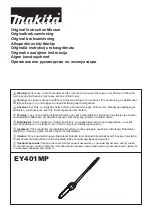
NOTE: Make sure that Bridge is locked and the
fence machine is in the center of its range and
locked to prevent any lateral movement of carriage.
B. Attach Fence Brackets
Place the shims under each end of fence again. Install
the Back Fence Clamp bracket under out feed end of
fence engaging the ¼” nuts into one or both fence T-
slots. Push against rail and securely tighten screws
(Figure 15).
Install the Front Fence Clamp bracket by engaging its
two ¼” nuts into the two lower fence T-slots. Push in,
align clamp bottom surface to rail top surface and
securely tighten screws (Figure 16).
NOTE: To achieve a gap under infeed end of fence,
you may need to add another layer of UHMW tape to
the bottom surface of the front fence clamp. (An
extra strip of UHMW tape is packed with the Rail
Mounting Hardware.
)
Remove shims from underneath fence. Check slip fit of
fence brackets along rails by moving fence. Do not
force so tight against rails as to cause binding nor leave
too loose as this may affect fence parallelism when
clamping bridge.
Fig. 15
Fig. 16
7. FINAL ALIGNMENT
The normal criteria for table saw fence alignment is to
skew the fence away from the trailing edge of saw blade
to prevent binding, burning and/or secondary scoring
during cutting operations. This skew should be .003” to
.005” greater than the maximum wobble of your saw
blade.
Note:
If you use your dust collector during table saw
operations, you can align your fence perfectly parallel to
blade. The vacuum porting on the lower face of your
SmartFence will hold the work piece against fence and
prevent any secondary scoring (Ideal for cutting
veneer!).
Raise your saw blade. With your fence machine still in
the center of its range and locked, release the bridge
clamp and slide complete setup to touch fence to saw
blade. Clamp bridge in place.
To Set Fence Parallel To Blade:
Check contact of blade to fence. If necessary to correct
alignment (your blade may be out of parallel to the miter
gauge slot), loosen the two fence mounting screws on
back of fence and place the necessary shims (either
magic tape or masking tape work well) on one side of
bracket between fence and machine. Securely tighten
fence-mounting screws after any adjustment.
To Set a Fence Skew:
Take a dollar bill folded in half to use as a shim
between fence and trailing edge of blade. Loosen
the 2 fence mounting screws on back of fence and
place the necessary shims between one side of
bracket and back of fence until fence touches
blade at its leading edge and pinches the dollar bill
at its trailing edge. Securely tighten fence-
mounting screws.
Lower saw blade.
Final Adjustment
Release cam lever on fence machine and slide
positioner fully open to closed. If any binding
occurs, first check fence clamps for binding. If
binding persists, slightly loosen gib screws on
Clincher (see Clincher Handbook) until you get
smooth travel over its full range.
With the fence machine set to the center of its
range and locked in place, release bridge clamp
and slide complete unit down the rails. If any
binding occurs recheck previous setup procedures
for rails, table elevation and fit of fence and bridge
clamps to rails.
-8-
Summary of Contents for SAW TRAIN
Page 11: ......






























